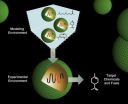(Press-News.org) A magnetic resonance imaging (MRI) scan for coronary heart disease is better than the most commonly-used alternative, a major UK trial of heart disease patients has shown.
The findings by University of Leeds researchers could change the way that people with suspected heart disease are assessed, potentially avoiding the need for tests that are invasive or use ionising radiation.
Full results of the study, which was funded by a £1.3 million grant from the British Heart Foundation (BHF), are published online today by the Lancet medical journal.
Coronary heart disease (CHD) is a leading cause of death and disability worldwide. In the US, an estimated 18 million men and women are living with the condition, resulting in an estimated cost to the economy of $177.1 billion in 2010.
CHD is caused when vital arteries serving the heart become narrowed or blocked by a build-up of fatty substances. This can lead to severe chest pain, known as angina, and if the condition worsens and remains untreated, patients may have a heart attack.
Patients with chest pain who are suspected of having angina will typically be sent to hospital for further tests. These tests will confirm the diagnosis of CHD and help doctors decide on the best course of treatment, which may involve drug therapy, a balloon 'stretch and stent' procedure to open-up narrowings in the heart's blood vessels - or a heart bypass operation.
At the moment, patients with suspected angina are most likely to have either an angiogram - an invasive test where dye is injected directly into the heart's arteries – or a non-invasive imaging test called SPECT. Unlike MRI scans, angiograms and SPECT tests both involve ionising radiation.
A five-year study by University of Leeds researchers, involving 752 patients, has now shown that an MRI scan is a reliable way of detecting signs of significant CHD. The researchers also showed that MRI was better than SPECT at diagnosing CHD and at ruling out heart disease in patients who did not have the condition.
This is the first time that MRI has been compared head-to-head against the 'gold standard' tests for CHD in such a large group of patients. The results may now lead healthcare policy-makers to re-think guidance on the tests that patients with suspected CHD should be offered.
University of Leeds' Dr John Greenwood, who led the study, said: "We have shown convincingly that of the options available to doctors in diagnosing coronary heart disease, MRI is better than the more commonly-used SPECT imaging test. As well as being more accurate, it has the advantage of not using any ionising radiation, sparing patients and health professionals from unnecessary exposure."
"The MRI technique could be used widely and not just in the UK," Dr Greenwood added. "The scans were all carried out on a standard 1.5 Tesla scanner – exactly the type of MRI scanner that you would find in most hospitals today."
Professor Peter Weissberg, Medical Director at the British Heart Foundation, said: "For patients suffering with chest pains, there are a number of tests that can be used to decide whether their symptoms are due to coronary heart disease or not. This research shows that a full MRI scan is better than the most commonly used alternative - a SPECT scan using a radioactive tracer.
"MRI has the additional advantage that it doesn't involve radiation. At present, not all hospitals have the expertise to undertake such scans but these findings provide clear evidence that MRI should be more widely used in the future."
###
For more information
Contact: Paula Gould, University of Leeds Communications & Press Office: Tel 44-113-343-8059, email p.a.gould@leeds.ac.uk
Contact: British Heart Foundation press office. Tel: 44-20-7554-0164 or 44-7764-290-381 (out of hours); Email newsdesk@bhf.org.uk
Notes to editors
1. Research published Online First in the Lancet: "CE-MARC: A Prospective Evaluation of Cardiovascular Magnetic Resonance and Single-Photon Emission Computed Tomography in Coronary Heart Disease" by Greenwood et al, DOI:10.1016/S0140-6736(11)61335-4
2. One of the UK's largest medical, health and bioscience research bases, the University of Leeds delivers world leading research in medical engineering, cancer, cardiovascular studies, epidemiology, molecular genetics, musculoskeletal medicine, dentistry, psychology and applied health. Treatments and initiatives developed in Leeds are transforming the lives of people worldwide with conditions such as diabetes, HIV, tuberculosis and malaria. http://www.leeds.ac.uk
3. The British Heart Foundation (BHF) is the nation's heart charity, dedicated to saving lives through pioneering research, patient care, campaigning for change and by providing vital information. But we urgently need help. We rely on donations of time and money to continue our life-saving work. Because together we can beat heart disease. For more information visit http://www.bhf.org.uk/pressoffice
MRI scan 'better' for heart patients
2011-12-23
ELSE PRESS RELEASES FROM THIS DATE:
How bacteria fight flouride
2011-12-23
Yale researchers have uncovered the molecular tricks used by bacteria to fight the effects of fluoride, which is commonly used in toothpaste and mouthwash to combat tooth decay.
In the Dec. 22 online issue of the journal Science Express, the researchers report that sections of RNA messages called riboswitches – which control the expression of genes — detect the build-up of fluoride and activate the defenses of bacteria, including those that contribute to tooth decay.
"These riboswitches are detectors made specifically to see fluoride," said Ronald Breaker, the Henry ...
Genetic study of black chickens shed light on mechanisms causing rapid evolution in domestic animals
2011-12-23
The genetic changes underlying the evolution of new species are still poorly understood. For instance, we know little about critical changes that have happened during human evolution. Genetic studies in domestic animals can shed light on this process due to the rapid evolution they have undergone over the last 10,000 years. A new study published today describes how a complex genomic rearrangement causes a fascinating phenotype in chickens.
In the study published in PLoS Genetics researchers at Uppsala University, Swedish University of Agricultural Sciences, North Carolina ...
Rapid evolution in domestic animals sheds light on the genetic changes underlying evolution
2011-12-23
A new study describes how a complex genomic rearrangement causes a fascinating phenotype in chickens in which a massive expansion of pigment cells not only makes the skin and comb black, but also results in black internal organs. Published in PLoS Genetics, researchers at Uppsala University, the Swedish University of Agricultural Sciences, North Carolina State University, and National Chung-Hsing University investigated the genetic basis of fibromelanosis, a breed characteristic of the Chinese Silkie chicken.
"We have shown that the genetic change causing fibromelanosis ...
Chinese fossils shed light on the evolutionary origin of animals from single-cell ancestors
2011-12-23
All life evolved from a single-celled universal common ancestor, and at various times in Earth history, single-celled organisms threw their lot in with each other to become larger and multicellular, resulting, for instance, in the riotous diversity of animals. However, fossil evidence of these major evolutionary transitions is extremely rare.
The fossils, reported this week in Science, preserve stages in the life cycle of an amoeba-like organism dividing in asexual cycles, first to produce two cells, then four, eight, 16, 32 and so on, ultimately resulting in hundreds ...
Canine Trade Group Opens New 300-Acre Training Facility in Dover, Delaware
2011-12-23
One of the most extensive US-based dog training companies, Canine Trade Group, is proud to introduce a new 300 acre training facility in Dover, Delaware where its Professional Dog Trainer's Course will be held. Owned and operated by world-renowned dog trainer John Van Olden, Canine Trade Group offers customized training programs for dog trainers and their dogs. The new Dover Training Facility boasts a private, 20-run climate controlled kennel, an abundance of training field space, as well as accommodations such as on-site lodging or a country inn located less than a mile ...
Scientists engineer mosquito immune system to fight Malaria
2011-12-23
Researchers at the Johns Hopkins Malaria Research Institute have demonstrated that the Anopheles mosquito's innate immune system could be genetically engineered to block the transmission of malaria-causing parasites to humans. In addition, they showed that the genetic modification had limited impact on the mosquito's fitness under laboratory conditions. The researchers' findings are published December 22nd in the Open Access journal PLoS Pathogens.
In this study, Dimopoulos and his team genetically engineered Anopheles mosquitoes to produce higher than normal levels ...
Double trouble: Concomitant immune challenges result in CNS disease
2011-12-23
A research team led by Glenn Rall at the Fox Chase Cancer Center in Philadelphia, PA developed a novel mouse model to show that a fatal central nervous system (CNS) disease can be caused by a pathogen that does not replicate in the CNS. The results of this new study are published December 22nd in the Open Access journal PLoS Pathogens.
The authors found that the immune response induced in response to a peripheral viral infection can be "mis-recruited" to the brain, where these activated immune cells can then lead to inflammation-induced neuropathology and disease. While ...
CAD for RNA
2011-12-23
The computer assisted design (CAD) tools that made it possible to fabricate integrated circuits with millions of transistors may soon be coming to the biological sciences. Researchers at the U.S. Department of Energy (DOE)'s Joint BioEnergy Institute (JBEI) have developed CAD-type models and simulations for RNA molecules that make it possible to engineer biological components or "RNA devices" for controlling genetic expression in microbes. This holds enormous potential for microbial-based sustainable production of advanced biofuels, biodegradable plastics, therapeutic ...
For every road there is a tire
2011-12-23
KANSAS CITY, MO -- Life is complicated enough, so you can forgive the pioneers of DNA biology for glossing over transcriptional elongation control by RNA polymerase II, the quick and seemingly bulletproof penultimate step in the process that copies the information encoded in our DNA into protein-making instructions carried by messenger RNA.
In a new report appearing in the Dec. 23, 2011, issue of Molecular Cell, researchers at the Stowers Institute for Medical Research add not just a new layer, but a whole new dimension to transcriptional elongation control with evidence ...
Facebook Marketing Strategist Shows Chiropractors How to Get Endless New Patient Referrals from Social Media
2011-12-23
Chiropractic Internet marketing strategist and social media expert, Dr. Matthew Loop, has announced he'll continue to show DCs how to create an overwhelming presence on Facebook, which can easily net doctors an extra 20-30 new patients per month just from the social network. Dr. Loop's been helping fellow chiropractors master social media marketing since 2005-2006, which gives him an experience-based edge over other industry consultants.
He's garnered a well deserved reputation as the "go-to" guy for chiropractors that want to dramatically improve their new ...



